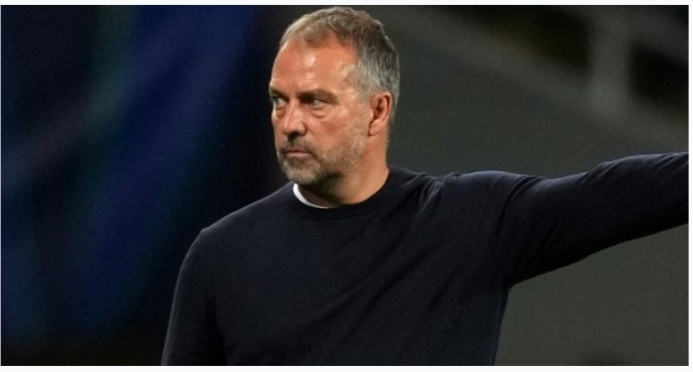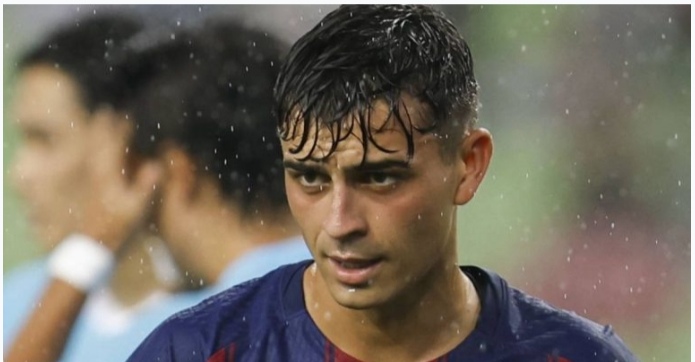The atmosphere at FC Barcelona is buzzing with anticipation as speculation grows over a possible tactical evolution under head coach Hansi Flick.
Since taking the reins, Flick has breathed new life into the squad through a high-intensity, aggressive playing style. However, recent developments suggest he may be considering a strategic pivot—one that could reshape Barcelona’s identity on the pitch as they aim for major titles in 2025.
Flick initially implemented a clear tactical foundation: a 4-2-3-1 formation built around high pressing, vertical transitions, and disciplined ball control. The results have been largely positive, with Barça enjoying a 70.6% win rate in La Liga during the 2024–25 season, netting 82 goals and delivering in crucial fixtures.
Veteran striker Robert Lewandowski, now 36, has led the charge with 22 goals, supported by Raphinha and rising star Lamine Yamal, whose contributions reflect the team’s successful mix of youth and experience.
But despite their attacking firepower, defensive issues have begun to emerge. Barcelona has conceded 32 goals in 34 league matches—a solid figure, but not on par with elite European standards. By comparison, Flick’s Bayern Munich side conceded just 26 goals in a similar period. Goalkeeper Wojciech Szczęsny has come under scrutiny following key errors, including rebound mishandlings in vital Champions League clashes like the one against Borussia Dortmund.
These defensive lapses—paired with a relatively young squad averaging 26.3 years—have sparked internal debate. Flick is reportedly considering incorporating seasoned players like Ilkay Gündogan into a more cautious and controlled system to strike a better balance.
Hints of this possible shift became more pronounced following a 2-2 draw with Real Madrid in August 2024. Despite dominating possession, Barcelona allowed numerous shots on target. Flick’s post-match remarks highlighted the need for improved defensive discipline, fueling rumors of a move to a more compact structure—potentially a 4-4-2 or 3-5-2 formation.
Such a change would emphasize defensive shape and midfield strength, possibly at the expense of some attacking flair. It could also mean redefining player roles: Yamal might be repositioned as a false nine to exploit his pace and playmaking, while older players like Lewandowski could take on less physically taxing responsibilities to extend their impact.
As these tactical discussions unfold, fans and analysts alike are watching closely. A shift in approach could mark a significant turning point in Flick’s Barcelona project—one that aims not just for flair, but for silverware.
This potential tactical shift is stirring debate.
Barcelona’s footballing identity is deeply rooted in an elegant, possession-dominant style pioneered by legends like Johan Cruyff, Pep Guardiola, and most recently, Xavi Hernández. Known globally as “tiki-taka,” this philosophy revolves around intricate passing, spatial control, and sustained attacking pressure.
However, Hansi Flick’s tactical lineage—shaped at Bayern Munich—is notably different. His preference for direct, vertical play contrasts with the traditional Barça model. Although the current squad still averages around 60.8% possession, a drop from historical highs, speculation that Flick might lower that further in favor of greater pragmatism has ignited discussion: is Barcelona willing to compromise its iconic style in pursuit of trophies?
The implications run deep, especially for graduates of La Masia.
Young talents like Lamine Yamal, Pau Cubarsí, and Alejandro Balde have thrived in a system that demands both technical precision and physical intensity. A transition to a more compact and conservative setup could reshape their roles or limit their minutes. Cubarsí, for example, might benefit from added defensive structure, while wide players such as Ferran Torres and Ansu Fati could find themselves on the fringes if width becomes less central to the game plan.
That said, a shift could also open doors for adaptable players. Dani Olmo, known for his tactical intelligence, and emerging prospects like Noa Darwich, could thrive in roles that demand versatility and disciplined positioning.
From a medical standpoint, the current high-press system has contributed to a concerning rise in muscular injuries this season. Flick and his support staff have been actively collaborating with fitness experts to manage workloads, and a tactical adjustment toward less physically taxing play could help safeguard player health across the full campaign.
This move also reflects broader strategic priorities—sustainable performance over an intense season and long-term squad durability.
Externally, the stakes remain high.
Fans continue to cherish Barcelona’s beautiful football, but patience wears thin in the absence of silverware. With Real Madrid and Europe’s elite maintaining relentless pressure, the demand for tangible success intensifies. Flick’s recent contract extension through 2027 and the firm backing of President Joan Laporta provide a mandate for change, but the room for missteps is narrow.
Should this transition falter, the backlash could echo past managerial failures—highlighting just how delicate the balance is between evolution and tradition at a club like Barcelona.










